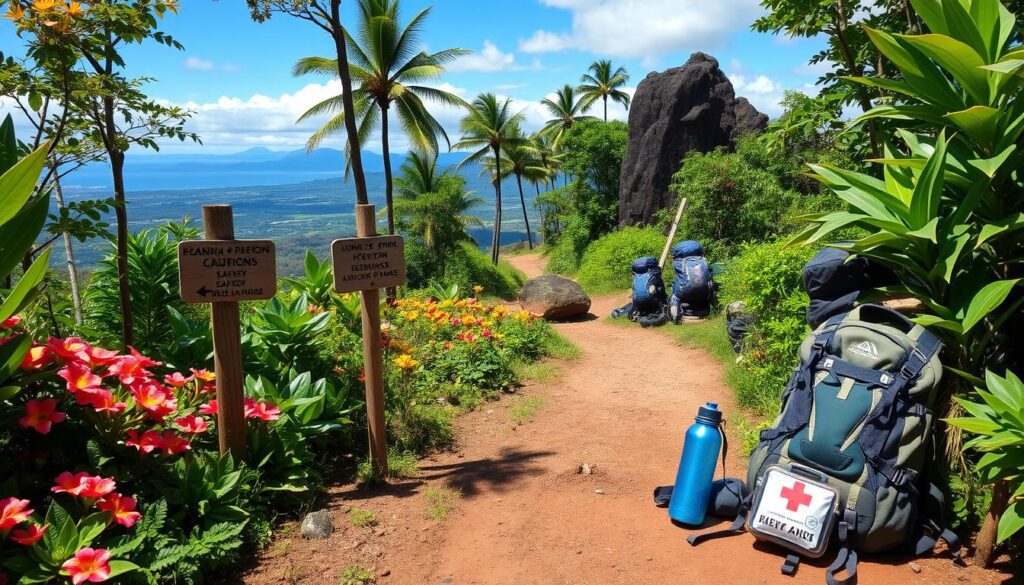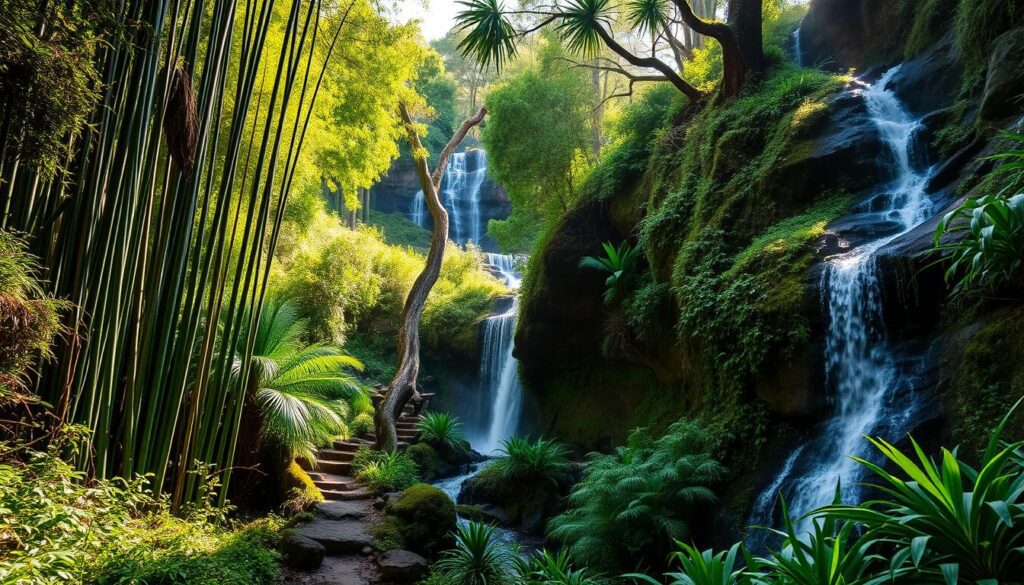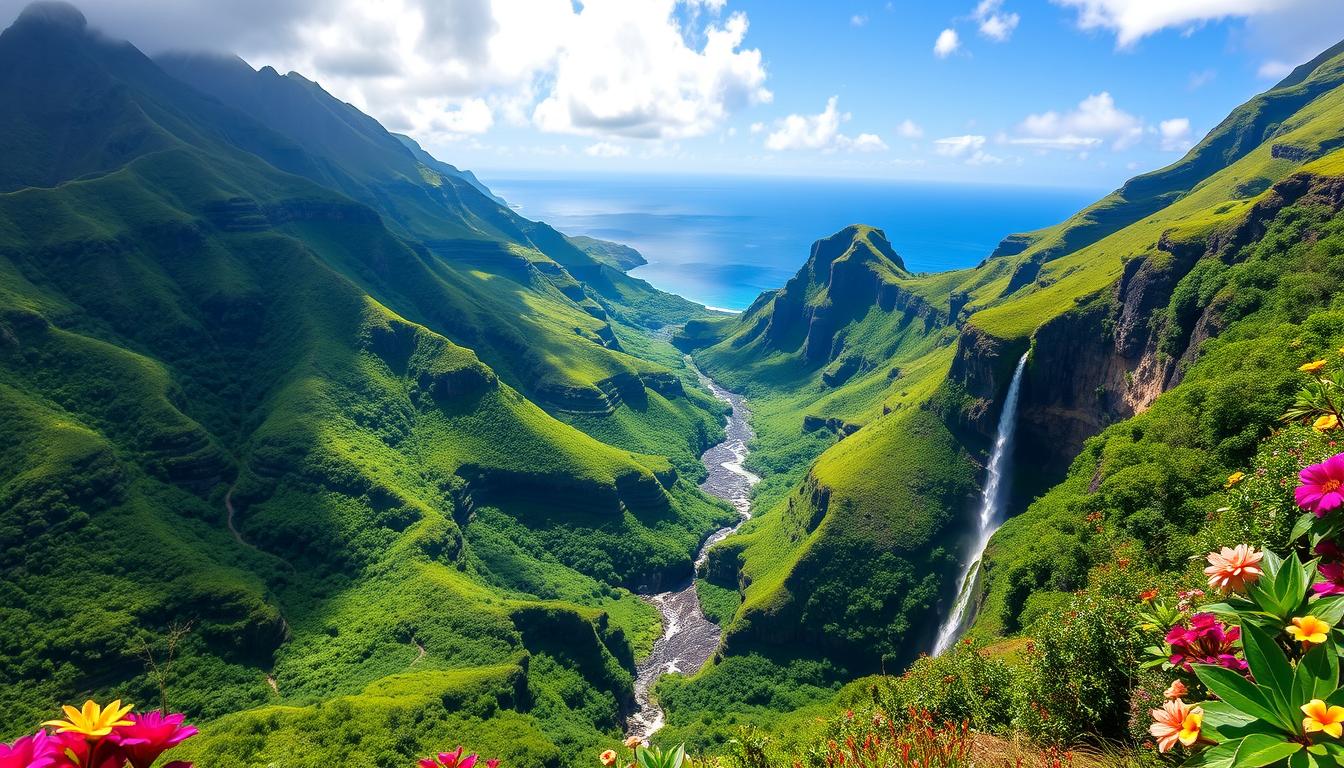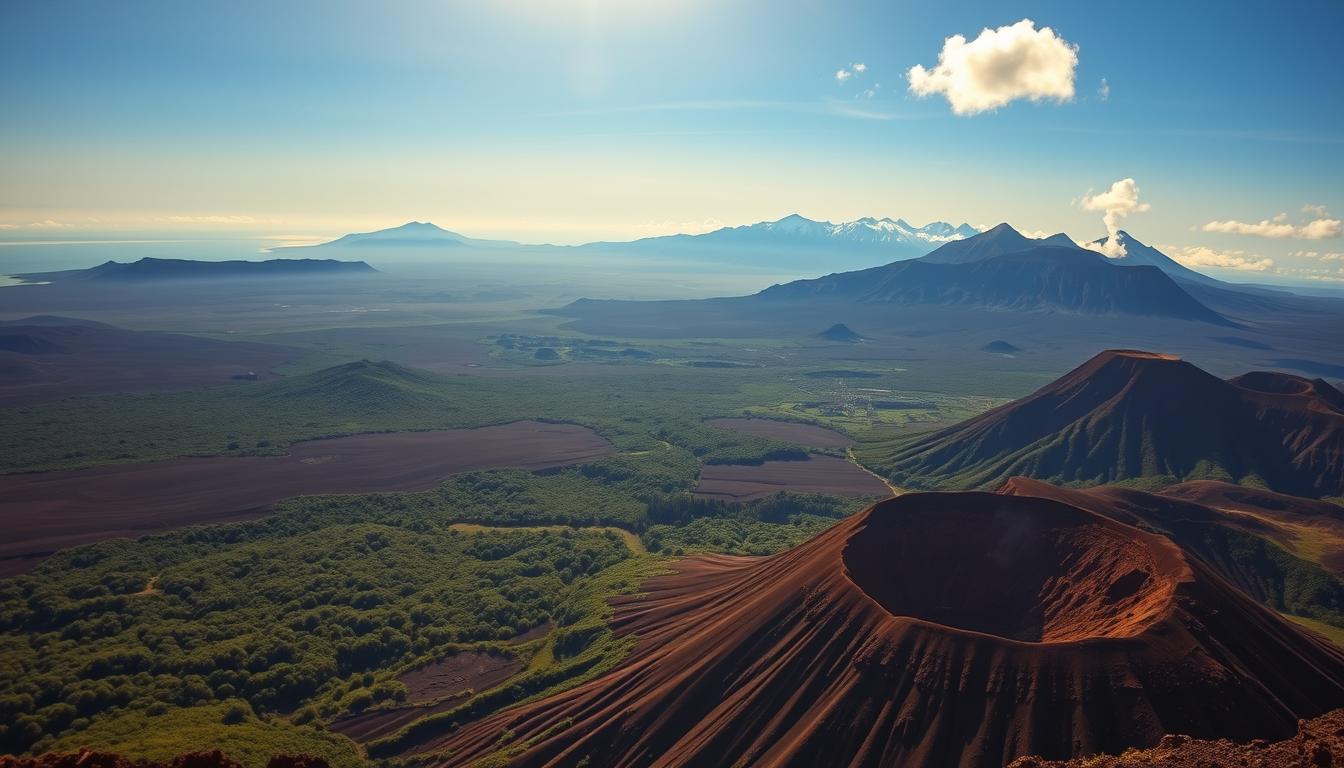Hawaii is a paradise for outdoor lovers, boasting incredible hiking trails that traverse varied landscapes. From dense rainforests and volcanic terrains to hidden coastal paths, each trail offers a unique glimpse into the islands’ natural beauty. Hikers can encounter rare species, cascading waterfalls, and breathtaking views. Whether you’re just starting out or have years of hiking under your belt, Hawaii’s trails cater to all levels and interests.
Key Takeaways
- Hawaii offers over 200 hiking trails on the island of Oahu alone, catering to various skill levels
- The diverse terrain includes volcanic landscapes, rainforests, and coastal ridgelines with features like waterfalls
- Popular easy hikes include Diamond Head, Manoa Falls, and Makapu’u Lighthouse trails
- Challenging hikes like Koko Crater and Olomana Trail provide a thrilling experience for adventurous hikers
- The best times to hike in Hawaii are during the shoulder seasons of mid-April to early June and September to mid-December
Exploring Hawaii’s Lush Rainforests and Volcanic Landscapes
Hawaii’s hiking trails lead adventurers through a world of natural wonders. From the lush rainforests to the unique volcanic landscapes, each trail offers a unique experience. These paths allow hikers to immerse themselves in Hawaii’s diverse ecosystems, making it a top destination for outdoor lovers.
Exploring Hawaii’s Rainforests
Oahu boasts some of the most stunning rainforests globally. The Manoa Falls Trail showcases a 150-foot waterfall, while the Aihualama Trail winds through lush vegetation for 4.5 miles. The Kuliʻouʻou Ridge Trail and Moanalua/Kamananui Valley Trail also offer opportunities to explore native Hawaiian ecosystems.
Trekking Through Volcanic Landscapes
Hawaii’s trails also reveal the islands’ volcanic landscapes. The Kilauea Iki Trail in Hawaii Volcanoes National Park is a 4-mile loop through a former crater. The Pololu Valley Lookout hike on the Big Island offers a valley view before descending to a black sand beach. The Sliding Sands Trail in Haleakala National Park on Maui is an 11-mile round-trip journey into the volcano, providing a unique experience.
| Hike | Location | Length | Difficulty |
|---|---|---|---|
| Kalalau Trail | Kauai | 22 miles round-trip | Rugged |
| Diamond Head State Monument Trail | Oahu | 1.6 miles round-trip | Moderate |
| Lanikai Pillbox Hike | Oahu | N/A | Moderate |
| Kilauea Iki Trail | Big Island | 4 miles loop | Moderate |
| Pipiwai Trail | Maui | 4 miles round-trip | Moderate |
Iconic Trails: The Kalalau Trail on Kauai
The Kalalau Trail, a 11-mile path along Kauai’s Nāpali Coast, is a true gem. It’s a challenging hike that offers a deep dive into the Kalalau Valley’s natural splendor. This trail leads to the secluded Kalalau Beach, a true paradise.
This trail winds through five lush valleys, showcasing stunning sea cliffs, waterfalls, and the Pacific Ocean. It’s a journey for the seasoned hiker, promising to reveal Kauai’s most dramatic landscapes.
| Trail Details | Facts |
|---|---|
| Length | 11 miles one-way (22 miles round-trip) |
| Terrain | Steep climbs and descents, narrow ridges, and challenging stream crossings |
| Permits | Required for camping and day hikes beyond Hanakapi’ai Valley |
| Difficulty | Intermediate to advanced |
| Time Required | 2 to 4 days to complete the full trail |
| Elevation Gain | 5,000 feet |
| Notable Sights | Nāpali Coast, Hanakoa Falls, Kalalau Beach |
Exploring the Kalalau Trail demands preparation for its rugged terrain. Hikers face steep climbs, narrow ridges, and unpredictable weather. Essential gear includes sturdy boots, backpacking equipment, and first-aid kits for a safe adventure.
The journey along the Kalalau Trail is a chance to experience Kauai’s natural beauty. From the lush Kalalau Valley to the stunning Kalalau Beach, it’s a path to unforgettable moments. With the right planning, hikers can embark on an awe-inspiring journey through Hawaii’s landscapes.
Accessibility Challenges: Trailhead Parking and Permits
Hikers face significant hurdles when accessing Hawaii’s trails. Many popular routes lack designated parking, leading to parking on narrow streets or remote lots. This is especially daunting due to flash floods and muddy conditions during the rainy season.
Additionally, some trails require advanced reservations or permits, which can be hard to get, especially when many are visiting. Hikers need to arrive early, plan their parking, and secure permits for a successful hike.
- Most trailheads on Oahu do not have designated parking areas
- Only a handful of trails in the state park system of Oahu have parking lots
- Parking along the street or in a neighborhood is required for many hikes in Hawaii
- The price for a permit to access trails on military installations, forest reserves, or private property is about $2.50
Hikers must be proactive in planning to overcome Hawaii’s trailhead challenges. By understanding parking and permit needs, visitors can better enjoy these natural wonders responsibly.
Hawaii Hiking Trails: Safety Considerations

Hiking in Hawaii demands extra caution and preparation. The islands’ unique geography and climate present specific challenges. Hikers must be aware of these to ensure a safe and enjoyable adventure.
Navigating Flash Floods and Muddy Trails
Flash floods are a major safety concern for Hawaii hikers. The state’s isolated location and tropical climate make it prone to sudden, intense rainfall. This can quickly turn serene trails into dangerous waterways. Hikers should be especially cautious when walking through narrow gulches or near streams and rivers.
The frequent rain and humidity in Hawaii’s interior also lead to muddy, slippery trails. This increases the risk of falls and injuries, especially on steep terrain. Wearing proper footwear with good traction is crucial for safe navigation.
Steep Terrain and Changing Weather
Many Hawaii hiking trails feature steep, exposed terrain, posing a risk of serious injuries from falls. Hikers need to be physically fit and prepared for these demanding hikes. The weather in Hawaii can also change quickly, with tropical storms and high winds adding unpredictability. It’s vital to stay informed about current and forecasted conditions.
To ensure a safe and enjoyable hiking experience in Hawaii, preparation is key. Hikers should pack appropriate gear, such as sturdy hiking boots, rain gear, and plenty of water and snacks. Researching trail conditions, checking weather forecasts, and knowing one’s physical capabilities are also essential before starting a hike.
Navigating Trails and Spotting Wildlife
Hiking in Hawaii’s scenic landscapes is exhilarating but demands careful navigation and wildlife awareness. Trails often use flag marker systems, which can be mistaken for hunting trails. This can lead adventurers astray. It’s wise to download detailed trail maps and use tools like compasses to stay on track and avoid getting lost.
Though rare, wildlife encounters on Hawaii’s trails can be rewarding. Hikers might see mongooses, chameleons, and seabirds. Wild hogs or goats could also appear. Oʻahu boasts nearly 200 bird species, with 16 native to the island. The endangered Hawaiian monk seal, with about 1,500 remaining, can be spotted along coastlines.
It’s vital to respect Hawaii’s wildlife for their safety and preservation. Keep a safe distance from animals like seals and turtles, at least 10 feet away. Conservation efforts protect Hawaii’s unique ecosystem and diverse species, attracting nature lovers and tourists.
| Wildlife Sightings | Likelihood of Encounter |
|---|---|
| Spinner Dolphins | 90% during dolphin cruises |
| Humpback Whales | Seasonal (May to December) |
| Native Hawaiian Sea Turtles (Honu) | Over 50 years lifespan |
Navigating Hawaii’s trails and spotting wildlife is both thrilling and rewarding. By using trail markers, navigation tools, and keeping a respectful distance, hikers can safely explore these natural wonders. They can also appreciate the unique beauty of Hawaii’s ecosystems.
Leave No Trace: Responsible Hiking in Hawaii
Exploring Hawaii’s natural wonders requires responsible hiking and adherence to Leave No Trace principles. These guidelines are essential for preserving the islands’ delicate ecosystems. They ensure the beauty of Hawaii remains for future generations.
The key Leave No Trace principles for hiking in Hawaii include:
- Plan Ahead and Prepare: Research the terrain, weather, and any permits before your hike. This ensures a safe and enjoyable experience while minimizing impact.
- Stay on Designated Trails: Following established trails reduces path widening and prevents habitat damage.
- Dispose of Waste Properly: Take all trash, including food and personal waste, back with you. This maintains the trails’ natural beauty.
- Leave No Trace: Avoid disturbing wildlife, removing natural elements, or creating new trails. These actions can harm the ecosystems.
- Minimize Campfire Impacts: Use designated campsites and follow local guidelines for campfires if camping is allowed.
- Respect Wildlife: Keep a safe distance and avoid feeding or approaching wildlife. This respects their natural behaviors.
- Be Considerate of Other Visitors: Be quiet, let others pass, and be mindful of your impact on the shared outdoor experience.
By following Leave No Trace principles, hikers play a crucial role in preserving Hawaii’s natural resources. This ensures the landscapes remain pristine for future generations. Remember, responsible hiking is key to a sustainable and rewarding outdoor experience in Hawaii.
| Impact of Trail Widening | Environmental Damage from Trail Cutting | Adherence to Leave No Trace Principles |
|---|---|---|
| Staying on established trails and walking in single file can significantly reduce path widening. This preserves delicate ecosystems from damage caused by human activity. | Trail cutting can lead to increased water runoff, erosion, and habitat destruction. Advocating against trail cutting safeguards Hawaii’s hiking trails. | Maintaining a natural environment by leaving wildlife undisturbed and avoiding feeding, cutting plants, or removing natural elements contributes to the conservation of Hawaii’s unique flora and fauna. |
Essential Gear for Hawaii Hiking Adventures
Embarking on a hiking adventure in Hawaii’s stunning landscapes necessitates careful gear selection. From moisture-wicking apparel to vital navigation tools, the right equipment is key. It ensures a safe and enjoyable trail experience.
Outfitting for Comfort and Protection
Choose lightweight, quick-drying clothing for Hawaii’s warm, humid climate. The Patagonia Tank Top is a favorite, offering breathability and moisture-wicking properties. It also resists odors. For added protection, consider the Patagonia Houdini Jacket. It’s water-resistant and shields against rain and wind.
Proper footwear is essential for Hawaii’s varied terrain. The Sunday Afternoons Eclipse Hat provides sun protection with its wide brim and mesh vents. Meanwhile, the Astral TR1 Junction Water Shoes offer traction and stability on wet surfaces.
Navigation and Hydration Essentials
Carry reliable navigation tools like a map, compass, and GPS device. These ensure you stay on track in Hawaii’s trails. The Osprey Mira 22 Hydration Pack is perfect for hydration and protection. It has a 2.5L reservoir and a built-in rain cover.
First-Aid and Safety Considerations
A well-stocked first-aid kit is crucial for any hike in Hawaii. Trails can pose challenges like muddy conditions and flash floods. The Day Hiker First Aid Kit is a compact, comprehensive option. It prepares hikers for minor injuries and emergencies.
With the right gear, adventurers can fully enjoy Hawaii’s natural wonders. From lush rainforests to volcanic landscapes, the islands offer breathtaking scenery.
Oahu’s North Shore Wonders: The Ehukai Pillbox Hike
The Ehukai Pillbox Hike is a hidden treasure on Oahu’s North Shore, perfect for outdoor lovers. This 2-mile trail combines breathtaking coastal views with a deep dive into Hawaii’s history.
The journey starts with a 30-minute ascent up the Koʻolau Mountains. It leads to two WWII bunkers, offering stunning views of beaches like the Banzai Pipeline. The hike’s elevation of 725 feet makes it moderately challenging. Yet, the views from the summit are unforgettable.
As you hike, you’ll find a picnic bench, a gift from Sunset Elementary School students. The first pillbox is a short walk past a flat ridge. The second is a 5-minute trek through large boulder rocks.
- Elevation: 725 Feet
- Length: 2 Miles Round Trip
- Duration: 60 to 90 Minutes
- Difficulty: Medium
The Ehukai Pillbox Hike is a great choice for those seeking a less crowded experience. It offers a mix of natural beauty, historical significance, and moderate difficulty. This hike is a must-visit for anyone exploring the Oahu North Shore.
Hawaii Hiking Trails: Volcanic Landscapes at Kilauea Iki
The Kilauea Iki Trail in Hawaii Volcanoes National Park offers a unique hiking experience. This 4-mile round-trip journey traverses the cracked lava rock of a former volcanic crater. It provides a rare view into the geological forces that have molded the islands.
Descending 400 feet over 6-7 switchbacks, hikers enter a volcanic landscape unlike any other. Along the path, they encounter native Hawaiian plants such as ʻŌhiʻa, Kōpiko, and Hāpuʻu. The ascent on the west side of the crater is 140 feet, followed by the 0.8-mile Crater Rim Trail that completes the loop.
- Distance of Kīlauea Iki Trail: 3.4 miles / 5.5 km
- Descent into Kīlauea Iki Crater: About 400 ft. over 6 or 7 switchbacks
- Short ascent on the west side of Kīlauea Iki Crater: 140 ft.
- Length of Crater Rim Trail to finish Kīlauea Iki Loop: 0.8 miles (1.3 km)
The Kilauea Iki Trail is a moderate to slightly challenging hike, with a total elevation gain of 500 feet. It usually takes 1.5 to 3 hours to finish the loop. The trail can be quite crowded, especially during peak hours. Visitors should be well-prepared with the right gear, plenty of water, and a desire to explore Hawaii’s stunning volcanic landscapes.
Maui’s Waterfall Wonders: The Pipiwai Trail

The Pipiwai Trail, located in the heart of Haleakala National Park on Maui, is a journey through a vibrant, tropical world. Spanning 4 miles round-trip, it’s a prime destination for those eager to explore Hawaii’s natural beauty. It leads to the awe-inspiring 400-foot Waimoku Falls, a sight not to be missed.
The trail starts just over half a mile from the parking area, offering a well-kept path that gradually climbs. It takes hikers from a dense rainforest to a vast bamboo forest. Here, a colossal banyan tree, with a footprint as large as a house, awaits. Along the path, the Falls at Makahiku, dropping almost 200 feet, can be seen cascading over a bamboo-covered cliff.
The trail’s crowning jewel is the Waimoku Falls, a 400-foot waterfall that cascades dramatically over a cliff. Surrounded by pristine wilderness and unique flora, it rivals the grandeur of the Halemaumau Crater at Hawaii Volcanoes National Park.
With a moderate difficulty level, the Pipiwai Trail draws over half a million visitors each year. It’s one of Maui’s most beloved hikes. The trail offers amenities like National Park Rangers, an information center, camping facilities, and restrooms, ensuring a safe and memorable journey for all.
Hawaii Hiking Trails: Sunrise Hikes and Coastal Views
Exploring Hawaii’s hiking trails is more than a physical challenge. It’s a chance to see the islands’ stunning natural beauty at its peak. Popular hikes on Oahu, like the Lanikai Pillbox Hike and the Makapu’u Lighthouse Trail, offer breathtaking sunrise views and coastal panoramas.
Starting these hikes early in the morning ensures a less crowded experience. It also allows adventurers to capture the serene beauty of Hawaii’s mornings. As the sun rises, hikers are treated to a magnificent display of colors reflecting off the islands’ renowned beaches and offshore islets. These coastal trails showcase the natural splendor of Hawaii from a unique vantage point, making them a must-visit for anyone seeking to immerse themselves in the islands’ stunning landscapes.
Whether you’re looking to witness a picturesque sunrise or simply enjoy the tranquil beauty of Hawaii’s coastlines, the island’s sunrise hikes and coastal trails are sure to leave a lasting impression. From the Lanikai Pillbox to the Makapu’u Lighthouse, these trails offer an unforgettable hiking experience that showcases the true essence of the Hawaiian Islands.

Scott Sweeney is the creator of Virtual Hawaii 360. Scott is a professional marketer and a lifelong Hawaii enthusiast. Scott splits time between Oahu and Dayton, Ohio. In addition to his marketing endevours, he is also a published Ukulele musician.





